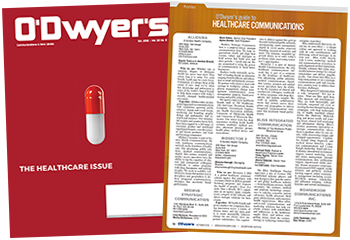 Wendy Lund |
With women accounting for 80 percent of healthcare spending, it’s critical that the healthcare industry gain a deeper understanding of what drives the health habits of this extremely influential demographic. But it’s not that simple. Not only do women tend to put their own health on the backburner, many say they don’t even have time to listen to health-related messages. That’s according to recent surveys of almost 1,350 women, which found that fewer than half of the respondents were willing or able to make time for their own health check-ups and screenings, yet excel at taking care of their families’ health.
These surveys are a key component of the #BeHealthiher movement, which was launched earlier this year by Redbook magazine; HealthyWomen, the nation’s leading independent health information source for women; and GCI Health, an integrated communications agency built around and inspired by the ever-changing face of healthcare, to explore the well-being habits of women ages 30-60. The goal of Healthiher is to help women make self-care a priority so they can become a “healthier her” for themselves and their families.
The key takeaway from this research for marketers is that it’s finally time to begin shifting their approach to one that embraces that women are the gatekeepers of the health of their family units, and their own health often comes behind that of their families. How can marketers simplify their messaging to truly affect this behavior?
When marketing to women, healthcare marketers need to understand where this woman is in her life and how she is juggling competing priorities — and health sometimes doesn’t even make it into the top 10. This aligns with the time when transitions in their health begin to take hold and they actually need to focus on their health more; therefore, it’s critical for healthcare marketers to reach her and deliver the messages and education that she needs during these transitional years.
However, because of where the woman is in her life, it’s difficult for her to pay attention to messages, and difficult for marketers to break through to her — especially if she isn’t going to the doctor. But the good news is that these women are open to self-help expertise. In the time they do have, they’re actively seeking information. It’s critical that healthcare marketers understand everything these women have going on in their lives so they can effectively communicate with them and educate them — on their terms.
Key findings from the survey
Women are overwhelmingly the ones in charge of their families’ healthcare. In the Healthiher survey, almost 83 percent of women said they were happy to be the ones calling the shots, and about 70 percent felt they handled their kids’ health “very well.”
But when it comes to taking care of themselves, more than 30 percent are not making time for things like regular health screenings.
Eighty percent felt they couldn’t delegate their families’ healthcare; 40 percent said doing so would simply be too complicated. And while younger women were twice as likely to have someone they could ask for help, they were no more likely to do it.
This means, though, that women also shoulder what sociologists call the “worry work”: all the planning and anticipating of their families’ needs. The result is stress: more than 90 percent of the women in the survey described their stress levels as “moderate to high,” with almost 40 percent indicating they had been diagnosed with anxiety or depression.
Most survey takers said it was lack of minutes rather than money that kept them from getting their checkups. Younger women were 10 percent less likely to get basic screenings and 10 percent more likely to say they put their kids’ care before their own.
While the women surveyed expressed concerns about things like reproductive health and Alzheimer’s disease, those who weren’t making time for regular screenings worried more about everything, from their stress levels to their eating habits to whether they’d get cancer.
Key tips for healthcare marketers
Redefine “balance.” Work-life balance is a buzz word today. Healthcare marketers must begin shifting that conversation to include health. It’s impossible to strike a work-life balance without the health aspects of taking care of ourselves.
Support physicians’ offices that cater to women’s schedules/priorities. Women are seeking out physicians who offer some basic policies: same-day visits, short wait times for routine checkups, and online appointment making/access to health records. Implement programs that help physicians offer this to their patients as a value-add.
Accept that their health may never be first to their families and communicate to them with this knowledge. Offer women tools that help them simplify and prioritize the health of the entire family unit (including themselves), understanding that their management of their family’s health is a key priority.
Understand what is feasible. Understand barriers to compliance. If a healthcare regimen is too much of a burden, women are simply not going to do it. Offer tools and resources to physicians and their patients on how to incorporate treatment/management into their patients’ busy lives.
This change cannot start and stop with individual women. The Healthiher research found that 77 percent of women indicated that their job schedules were the primary barrier to taking the time needed for regular screenings and necessary healthcare. As healthcare marketers, we need to challenge leaders in our industry and across the business sector with a call-to-action to create workplaces that encourage well-being and empower women to take care of themselves. Employers have the power — and an obligation — to make these changes. Not only will it benefit their employees and families, but it will benefit employers too: research shows that healthier and happier employees are more productive and motivated employees.
***
Wendy Lund is CEO of GCI Health.



 Lo Isidro, senior director at Real Chemistry with more than a decade of strategic communications and PA experience, has joined Narrative Strategies.
Lo Isidro, senior director at Real Chemistry with more than a decade of strategic communications and PA experience, has joined Narrative Strategies. Nelson Fernandez, former North American chair of APCO Worldwide and managing director of Burson-Marsteller, has joined Volunteers in Medicine Berkshires as director of communications and PA.
Nelson Fernandez, former North American chair of APCO Worldwide and managing director of Burson-Marsteller, has joined Volunteers in Medicine Berkshires as director of communications and PA. Lilit Bargar, who was most recently an EVP in the healthcare practice at Weber Shandwick, comes on board at GCI Health as EVP, corporate practice lead.
Lilit Bargar, who was most recently an EVP in the healthcare practice at Weber Shandwick, comes on board at GCI Health as EVP, corporate practice lead.
 Five ways that successful thought leaders are made.
Five ways that successful thought leaders are made.


 Have a comment? Send it to
Have a comment? Send it to 
No comments have been submitted for this story yet.